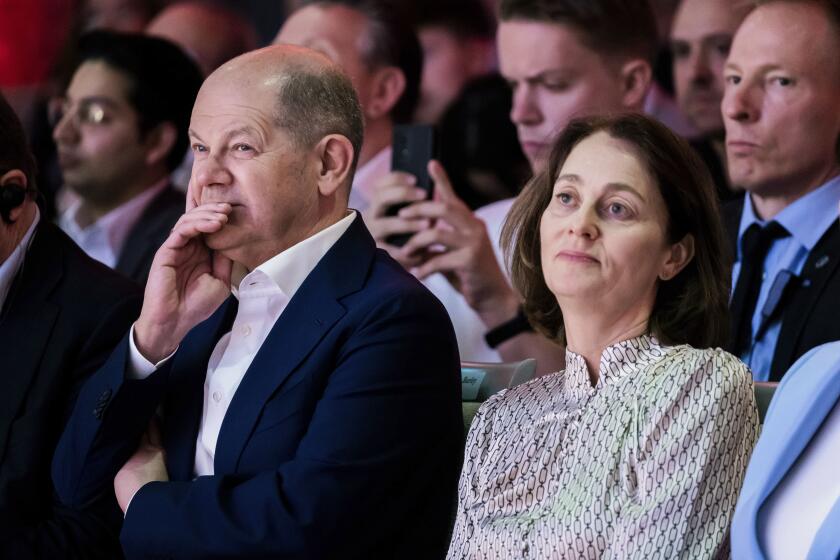Cambodians OK Guerrilla Presence in Capital : Asia: The three rebel groups, including the feared Khmer Rouge, are to open offices in Phnom Penh. But a peace settlement remains elusive.
More progress was reported in the Cambodian peace negotiations Tuesday, with an agreement reached to establish a “super government” in Phnom Penh and to allow the three resistance factions--including the feared Khmer Rouge guerrillas--to establish a presence in the capital.
Prince Norodom Sihanouk, who was deposed as leader of Cambodia in 1970, told a news conference after a second day of talks that he expects to return to Phnom Penh within weeks to take up residence at the royal palace with a retinue of “staff, cooks and doctors.”
An atmosphere of unusual optimism has surrounded the negotiations since they convened Monday in this seaside resort in Thailand. The meeting represented the first time since its creation last September that the all-party Supreme National Council actually conducted any business.
The council, which Sihanouk immediately dubbed a “super government,” consists of six representatives of the Phnom Penh government and six members from the guerrilla coalition that has waged a civil war against Phnom Penh since 1979.
The council is primarily a symbolic transitional body. With its own flag and national anthem, the council will send delegations to international meetings and receive ambassadors, but it will exercise virtually no practical power, which will remain in the hands of the government and the three resistance factions in the areas they control.
In its first decisions Monday, the council agreed to an “unlimited” cease-fire and the cessation of foreign military aid to the four parties, although monitoring of both agreements will be left to the parties for the time being.
The council also set aside a longstanding leadership dispute and appointed Sihanouk the “convener” of the council meetings, making him de facto chairman of the Supreme National Council and allowing it to start working.
The agreement Tuesday called for the establishment of a council headquarters in Phnom Penh and, perhaps more important, provided for each of the three resistance factions to open offices in the capital.
Under the agreement, each group will have its own compound guarded by its own armed forces and protected on the outside by troops from the Phnom Penh army.
The agreement will provide for the first armed Khmer Rouge troops in Phnom Penh since they were ousted from power in early 1979 after a four-year reign of terror in which more than 1 million people died.
While the Phnom Penh government has set restrictions on Khmer Rouge leaders returning to the country, Sihanouk said that Phnom Penh Premier Hun Sen has agreed to allow the two Khmer Rouge members of the council--Khieu Samphan and Son Sen--to come back to the capital.
“We will have to live there together,” Sihanouk said.
While some diplomats called the agreement a concession by the Khmer Rouge, the guerrillas will benefit greatly by having an official presence in Phnom Penh.
Sihanouk also said the council is asking the United Nations to arrange a tour of Cambodia by a U.N. military team and the commanders of the four parties to discuss the technicalities of implementing a cease-fire.
A major obstacle to a peace settlement still exists in the Phnom Penh government’s objections to a comprehensive peace plan worked out by the five permanent members of the U.N. Security Council last November.
The so-called Perm 5 plan calls for the dismantling of the four armies, U.N. military supervision of the cease-fire and U.N. administration of key ministries in an interim period leading up to a free election.
While Hun Sen issued a statement Tuesday insisting that he had never rejected the U.N. plan, his government has objected to the idea of dismantling its army.
The progress achieved since peace talks collapsed three weeks ago in Jakarta, Indonesia, appears largely to have been accomplished by putting consideration of the Perm 5 plan last instead of first, itself a major concession by the Khmer Rouge.
The four parties to the talks are the Phnom Penh regime led by Hun Sen, and the three resistance groups: the Khmer Rouge under Khieu Samphan, the Khmer People’s National Liberation Front under Son Sann and Sihanouk’s National United Front for an Independent, Neutral, Peaceful and Cooperative Cambodia.
The talks are to end this morning. Hun Sen is now scheduled to visit India, after which, Sihanouk said, Hun Sen has agreed to visit him at his residence in Pyongyang, North Korea.
After the Sihanouk-Hun Sen meeting, the Supreme National Council will reconvene at the Cambodian Embassy in Bangkok, Thailand, to consider remaining issues such as the Perm 5 plan.
Sihanouk said he may move back to Phnom Penh as early as August.
Diplomats said Sihanouk’s blossoming relationship with Hun Sen appears to have been a factor influencing the Khmer Rouge to agree to the proposals at Pattaya. Khmer Rouge concessions started appearing after Sihanouk said he plans to return to Phnom Penh.
Although it is the most powerful of the three resistance factions, the Khmer Rouge has failed to achieve military dominance in Cambodia, and its leaders have clearly resigned themselves--temporarily, at least--to seeking a political solution to the conflict.
More to Read
Start your day right
Sign up for Essential California for news, features and recommendations from the L.A. Times and beyond in your inbox six days a week.
You may occasionally receive promotional content from the Los Angeles Times.






